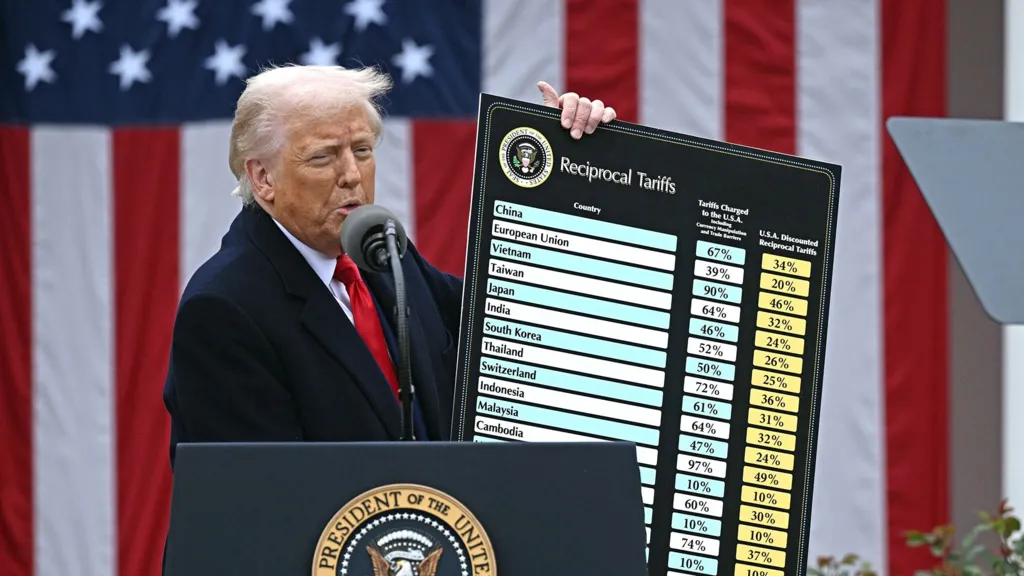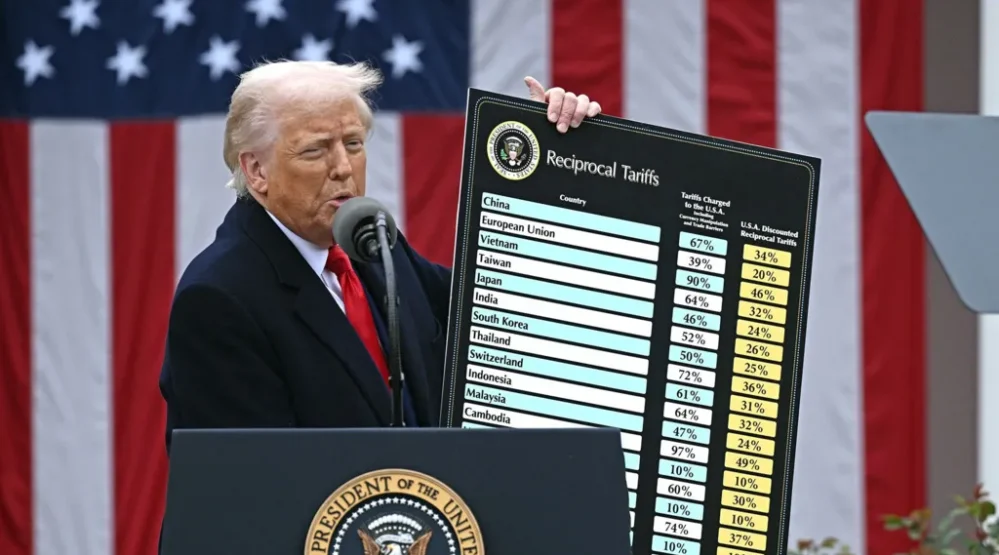
Trump holding tariff chart at rally with “America First” banner visible
With a flourish, a glossy chart in hand, Donald Trump announced what he hailed as “the greatest, most incredible, America-first tariff plan you’ve ever seen” at an official press conference. Standing in the White House Rose Garden, he gestured towards the chart illustrating U.S. tariff payments to various nations. “Folks, look at this! Look at these numbers! It’s unbelievable what we’ve been paying!”
And with that, Trump initiated what is rapidly becoming a global trade war. He declared a broad 10% tariff on most imported goods—with significantly higher rates for specific countries—promising to create a level playing field. “For decades, our country has been looted, pillaged, raped, and plundered by nations near and far, both friend and foe alike,” Trump asserted, his voice resonating across the Rose Garden.
However, while Trump framed the move as a victory for American manufacturing, much of the rest of the world viewed it as an economic upheaval.
“Folks, look at this! Look at these numbers! It’s unbelievable what we’ve been paying!”
Markets responded sharply. As Asia absorbed the news, Japan’s Nikkei index plummeted to its lowest point in eight months. European and U.S. stock futures declined steeply as investors sought safer investments like gold and bonds—a traditional indicator of financial unease. The diplomatic repercussions quickly followed.
China, already angered by previous tariffs, swiftly pledged retaliatory measures. “We will respond with firm and necessary actions,” Beijing stated, appearing undeterred by U.S. Treasury Secretary Scott Bessent’s warning that such actions would only escalate tensions. China now faces a total of 54% in tariffs on many of its exports to the U.S., and it seems prepared to retaliate.
Trump’s tariffs did not solely target America’s primary economic competitor. Close allies, including Japan and the European Union, also found themselves affected, facing tariffs of 24% and 20%, respectively. Even America’s neighbors, Canada and Mexico, were already subject to a 25% tariff on many of their goods.
European Commission President Ursula von der Leyen offered a strong condemnation. “These tariffs are a major blow to the global economy,” she stated, warning that if negotiations failed, the EU was ready to implement its own countermeasures. “The consequences will be dire for millions of people around the world.”
But for Trump, the tariffs were simply a logical response to what he perceives as years of unfair trade practices. “It’s simple, folks. They charge us, we charge them back. And guess what? We charge them more!” he boasted.
Not everyone shared this view. Within hours of his announcement, the U.S. Senate—with support from some Republican members—voted 51-48 to overturn Trump’s Canadian tariffs. The House, still under firm Republican control, was less likely to challenge him, but divisions within his party were already evident.
Meanwhile, Trump’s chief economic advisor, Stephen Miran, appeared on Fox Business to assure the public that, despite the disruption, the U.S. would ultimately benefit. “Are there going to be short-term bumps? Absolutely. But in the end, this will be great for America,” Miran said on the “Kudlow” program, seemingly unconcerned by the global market turmoil unfolding.
A key element of Trump’s tariff strategy was his order to close the “de minimis” rule loophole, which had allowed low-value packages (under $800) from China and Hong Kong to enter the U.S. without tariffs. “We’re stopping the scam,” Trump declared, linking the closure to efforts to combat fentanyl trafficking. China, predictably, denied any wrongdoing.
And this could be just the beginning. Reports indicate that more tariffs are being considered, potentially targeting semiconductors, pharmaceuticals, and critical minerals. Trump has also moved forward with separate tariffs on auto imports, scheduled to take effect this week.
Critics contend that the wider consequences could be severe. Higher tariffs translate to increased costs, which are often passed on to consumers. Analysts predict that American families could soon face significantly higher annual expenses for everyday goods. The move also risks hindering global economic growth—a concern for manufacturing sectors worldwide.
“Trump just hit Americans with the largest regressive tax hike in modern history,” stated Representative Gregory Meeks, the leading Democrat on the House Foreign Affairs Committee. “His reckless policies are not only crashing markets, but they will disproportionately harm working families.”
Despite the criticism, Trump remained resolute. “We’re making America rich again, folks. Rich!” he exclaimed before dramatically signing the latest tariff orders into law, to the applause of his supporters.
Sources and related content
